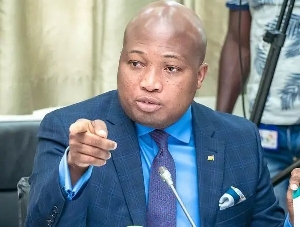The Need for Prudence in Decision-making
In the overall scheme of things, part of the directives issued by Ghana’s Minister of Lands and Mines to the new Board of Directors of the ailing Ghana Consolidated Diamonds, GCD, to extend its operations downstream of the Birim River to Akim Oda from its location at Akwatia, does not seem to be consistent with sound economic or political judgment.
While inaugurating the new Board on Wednesday Dec. 19, 2001, Hon. Kwadwo Adjei-Darko, reportedly, said, “there is vast amount of reserves located downstream of the Birim River towards Akim Oda,” adding that “the exploitation of the Birim reserves holds the key to the future of the company.”
All the excerpts from the honorable minister’s statement at the inauguration ceremony as posted Thursday, Dec. 20, on Ghanaweb.com, pointed to making GCD “attractive to prospective investors.” Unfortunately, there is no excerpt from Adjei-Darko’s statement directed at improving economic and other developmental interests of the voters who depend on the water from Birim River for their existence on a daily basis.
Question: Is the future of GCD more important to the honorable minister than the welfare of the voters whose ancestors acquired the property where they live, with access to water from Birim River in mind?
There are a number of concerns that need to be raised with Adjei-Darko’s directives to the GCD Board relative to the interests of constituents that inhabit the banks of Birim River downstream from Akwatia.
In the first instance, there is no defensible reason why GCD’s record at Akwatia has to be replicated anywhere in Ghana. Therefore it does not seem fair for the voters downstream of Birim River from Akwatia should be victimized with Akwatia’s existing experience.
Akwatia, like other mining townships such as Tarkwa and Obuasi, have suffered the worst forms of environmental degradation found anywhere in Ghana. The main Akwatia town is dirty while the “bungalow” area where the mining industry bosses live is spruced up and well kept. Uncovered trenches left by diamond prospectors have been the breeding ground of malaria-causing mosquitoes.
In recent times, the people of Akwatia have suffered the worst forms of cholera, obviously from sources associated with diamond mining. But above all, the diamond industry of Akwatia has been responsible for polluting the Birim River downstream since 1947, by persistent dumping of waste matter from its production process into it.
Since 1947, the water in the Birim River has maintained milky-brown color from Akwatia downstream while it is very clear upstream. In addition, silt from the diamond mining waste has contributed to thinning the water level of the river.
In October, this year, I raised the issue of pollution of the Birim River with Ghana's Deputy Minister of Works, Hon. Theresa Tagoe, when I met her in Philadelphia, Pa. (USA). Ms. Tagoe assured me Ghana's Environmental Protection Agency, EPA, was working on the issue. She was in Philadelphia seeking $50 million loan for a water supply project for the Sunyani area in Ghana.
Sunyani District is represented in Ghana’s parliament by Senior Minister, Hon. J. H. Mensah. South Birim District, including a chunk of the constituencies along the banks of Birim River, is represented in parliament by Hon. Yaw Osafo-Marfo, Minister of Finance and Hon. F. K. Owusu-Adjapong, Minister of Transport and Communications.
According to sources, Consolidated African Selection Trust, CAST, the predecessor to GCD, was located at Akwatia, as opposed to Akim Oda, because the chiefs and elders of the traditional area raised objection to that proposal, resulting in intense dispute with the colonial British administration.
The Akim Oda story is that the elders refused to give in to the colonial government unless an alternative source of drinking water was provided for the people. The British administration promised to supply pipe-borne water to Akim Oda from a stream near Kwanyarko, presently part of the Central Region of Ghana; failing that arrangement, CAST was located at Akwatia.
Sure, the people of Akwatia have access to pipe-borne water but its milky-brown color does not attract any constituency’s envy in Ghana.
In the economic sphere, ordinary citizens of Akwatia have had to depend on the largess of the local mission of the Catholic Church for their social safety net. As the regulations of CAST/GCD are written, it is the traditional rulers and their families who have been sharing in the spoils of Akwatia-based diamond industry while ordinary folks have to scratch the soil for existence. It is known that some residents of Akwatia dig up their bedrooms in search of diamonds to etch out a means of survival.
Members of Akim Oda’s older generation have memories of how clear and clean the water from Birim River was before 1947. They yearn for the pleasure of watching diamonds sparkling at the bottom of Birim River at high noon and how easy it was to have access to clean drinking water. Today, the people of Akim Oda have to depend on borehole for their drinking water!
In the roadmap for next year’s “World Summit for Sustainable Development”, WSSD, in Johannesburg, South Africa, the need for access to drinking water in Africa features prominently.
Addressing a forum Tuesday Dec. 4, 2001, at the Woodrow Wilson Center for Scholars in Washington, DC, Dr. Crispian Olver, Director-General of South Africa’s Environmental Affairs and Tourism, warned that with projected population growth, there is likelihood of problems in water supply for the world as a whole. According to Dr. Olver, 1.5 billion people live in water-deprived areas while 54% of available water is used for agricultural production. At the same time, 95% of sewage is dropped in the world’s waterways.
With regard to the grim figures associated with access to water, Dr. Olver advised African governments to work towards providing 50% of households with fresh water by 2015. Access to fresh water depends on the protection of waterways, including the rain forests that provide sustenance for rivers. Dr. Olver cautioned the need for African nations to balance consumption and production with the Earth’s capacity.
In recent debates associated with “conflict/blood diamonds”, it has emerged that there are reasons why diamond mining has wreaked havoc on the populations in Sierra Leone, Liberia and Angola while it is contributing positively to Botswana’s national economic development. One would have expected that Hon. Kwadwo Adjei-Darko would have taken notes from the Sierra Leonean and Angolan experiences and to come out with ideas that would not provoke the angst of affected populations living in areas where diamonds are located.
There is a ray of hope for the welfare of ordinary citizens in the GCD news story under discussion. Part of the story states, “Mr. James Lemaire, General Manager of the company later in interview with the Ghana News Agency asked government to resolve to reclaim land for farming in the area to give farmers a new lease of life.” There is an implication, here, that farmers in the diamond mining area have been deprived of the ability to work on their plots of land for survival, hence the call for rapid reclamation.
State guarantee of the profit interest of private enterprise without protection for the working people produces (and reproduces) social tension and conflicts. In post-colonial Africa, unbridled free enterprise has been the point of differentiation between governments that protect the interest of private profits and those that use political power of the state to promote welfare of society as a whole. Mr. Lemaire’s foresight, directed towards economic welfare of ordinary citizens, is the kind of magnanimity required of CEOs in post-colonial Africa.


















